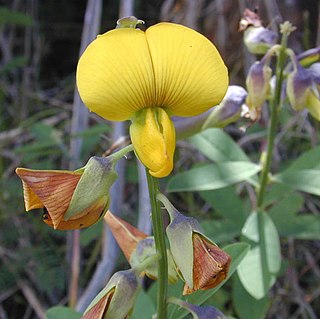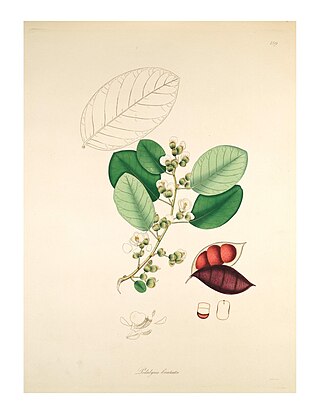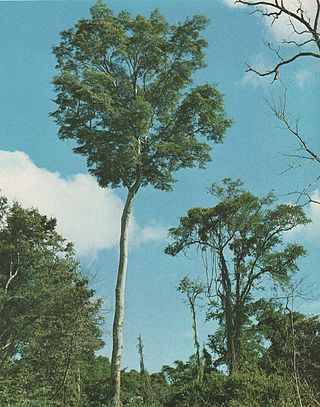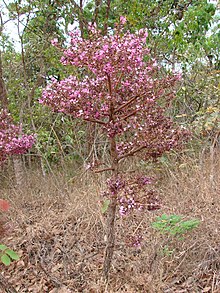
The Faboideae are a subfamily of the flowering plant family Fabaceae or Leguminosae. An acceptable alternative name for the subfamily is Papilionoideae, or Papilionaceae when this group of plants is treated as a family.

Styphnolobium is a genus of flowering plants in the pea family, Fabaceae. It includes nine species of small trees and shrubs native to China and to the Americas, from the southern United States to Colombia. It belongs to subfamily Faboideae, and was formerly included within a broader interpretation of the genus Sophora. It was recently assigned to the unranked, monophyletic Cladrastis clade. They differ from the genus Calia (mescalbeans) in having deciduous leaves and flowers in axillary, not terminal, racemes. The leaves are pinnate, with 9–21 leaflets, and the flowers in pendulous racemes similar to those of the black locust. Necklacepod is a common name for plants in this genus.

Centrolobium is a Neotropical genus of flowering plants in the family Fabaceae, assigned to the informal monophyletic Pterocarpus clade of the Dalbergieae. The genus comprises mostly large trees to 30 m tall, characterised by an abundance of orange peltate glands that cover most parts of the plant, and fruits that are large winged samaras to 30 cm long with a spiny basal seed chamber.

Machaerium is a genus of flowering plants in the family Fabaceae, and was recently assigned to the informal monophyletic Dalbergia clade of the Dalbergieae. It contains the following species:

Dalhousiea is a genus of flowering plants in the legume family, Fabaceae. It belongs to the subfamily Faboideae. It includes two species, one native to central Africa, and the other to eastern India, Bangladesh, and Myanmar.

Hymenolobium is a genus of flowering plants in the family Fabaceae. It includes 14 species of trees native to Central America and northern South America, ranging from Honduras to Bolivia and southeastern Brazil. Most species are native to Brazil, the Guianas, and Venezuela, with one extending into Peru, another into Ecuador, and one native to Central America. Trees are typically very tall and emergent in tropical humid lowland rain forest.

Luetzelburgia is a genus of flowering plants in the legume family, Fabaceae. It includes 14 species of trees and shrubs native to Brazil, Bolivia, and Colombia. Typical habitat is seasonally-dry tropical lowland woodland and wooded grassland, and occasionally lowland rain forests. The genus belongs to the subfamily Faboideae. It was traditionally assigned to the tribe Sophoreae, mainly on the basis of flower morphology; recent molecular phylogenetic analyses assigned Luetzelburgia into an informal, monophyletic clade called the "vataireoids". Keys for the different species of Luetzelburgia have been published.

The tribe Amorpheae is an early-branching clade within the flowering plant subfamily Faboideae or Papilionaceae. It is found from Mexico to Argentina. It was recently found to belong in a larger clade known informally as the dalbergioids sensu lato. This tribe is consistently resolved as monophyletic in molecular phylogenetic analyses. It is estimated to have arisen 36.9 ± 3.0 million years ago. A node-based definition for Amorpheae is: "the MRCA of Psorothamnus arborescens and Eysenhardtia orthocarpa." The tribe exhibits the following morphological synapomorphies: "epidermal glands throughout the plant body; dry, indehiscent fruits that are single-seeded; and terminal inflorescences."

The tribe Brongniartieae is one of the subdivisions of the plant family Fabaceae, primarily found in tropical regions of the Americas and in Australia The members of this tribe consistently form a monophyletic clade in molecular phylogenetic analyses. The tribe does not currently have a node-based definition, but morphological synapomorphies have been identified:
"stamens united by filaments in an adaxially open tube; anthers alternately long and basifixed, short and versatile; anther connective inconspicuous; septa present between seeds in pods; aril lateral lobe present and fitting into heel of funicle; fine red glandular processes present in axils; and pollen tricolporate with opercula and no definite endoaperture."

The tribe Dalbergieae is an early-branching clade within the flowering plant subfamily Faboideae. Within that subfamily, it belongs to an unranked clade called the dalbergioids. It was recently revised to include many genera formerly placed in tribes Adesmieae and Aeschynomeneae and to be included in a monophyletic group informally known as the dalbergioids sensu lato. The members of this tribe have a distinctive root nodule morphology, often referred to as an "aeschynomenoid" or "dalbergioid" nodule.

The tribe Dipterygeae is one of the subdivisions of the plant family Fabaceae. It was recently recircumscribed to include the following genera:

The tribe Indigofereae is a subdivision of the plant family Fabaceae. It is consistently recovered as a monophyletic clade in molecular phylogenies. The Indigofereae arose 30.0 ± 3.3 million years ago.

The tribe Swartzieae is an early-branching monophyletic clade of the flowering plant subfamily Faboideae or Papilionaceae. Traditionally this tribe has been used as a wastebasket taxon to accommodate genera of Faboideae which exhibit actinomorphic, rather than zygomorphic floral symmetry and/or incompletely differentiated petals and free stamens. It was recently revised and most of its genera were redistributed to other tribes. Under its new circumscription, this clade is consistently resolved in molecular phylogenies. Members of this tribe possess "non-papilionate swartzioid flowers[…]largely characterized by a tendency to lack petals combined with a profusion and elaboration of free stamens" and a "lack of unidirectional order in the initiation of the stamens". They also have "complete or near complete fusion of sepals resulting from intercalary growth early in development, relatively numerous stamens, and a single or no petal, with other petals not at all apparent in development." The tribe is predicted to have diverged from the other legume lineages 48.9±2.8 million years ago.

The vataireoids are an early-branching monophyletic clade of the flowering plant subfamily Faboideae that are mostly found in northern South America, primarily Brazil.

The non-protein amino acid-accumulating clade, also known as the Canavanine-accumulating clade is a clade of the flowering plant subfamily Faboideae that includes the majority of agriculturally-cultivated legumes. It is characterized by the accumulation of the non-proteinogenic amino acid canavanine in the seeds—a deterrent against herbivory. This phylogenetic trait was first recognized in the early 1980s. This clade is consistently resolved in molecular phylogenies. It contains many economically important genera, including Cicer, Glycine, Medicago, Phaseolus, Trifolium, Vicia, and Vigna.

The tribe Amburaneae is one of the subdivisions of the plant family Fabaceae. It has been circumscribed to include the following genera, which used to be placed in tribes Sophoreae and Swartzieae:

The Cladrastis clade is a monophyletic clade of the flowering plant subfamily Faboideae that is found in eastern Asia and southern North America. It is consistently resolved in molecular phylogenies and is sister to the Meso-Papilionoideae. Evidence for the existence of this clade was first proposed based on morphological (floral), cytological, and biochemical evidence. It is predicted to have diverged from the other legume lineages 47.4±2.6 million years ago.
The Andira clade is a predominantly Neotropical, monophyletic clade of the flowering plant subfamily Faboideae. The members of this clade were formerly included in tribe Dalbergieae, but this placement was questioned due to differences in wood anatomy and fruit, seed, seedling, floral, and vegetative characters. Recent molecular phylogenetic evidence has shown that they belong to a unique evolutionary lineage. It is predicted to have diverged from the other legume lineages in the late Eocene).

The Genistoids are one of the major radiations in the plant family Fabaceae. Members of this phylogenetic clade are primarily found in the Southern hemisphere. Some genera are pollinated by birds. The genistoid clade is consistently resolved as monophyletic in molecular phylogenetic analyses. It is estimated to have arisen 56.4 ± 0.2 million years ago. A node-based definition for the genistoids is: "the MRCA of Poecilanthe parviflora and Lupinus argenteus." One morphological synapomorphy has been tentatively identified: production of quinolizidine alkaloids. Some genera also accumulate pyrrolizidine. A new genus, to be segregated from Clathrotropis, has also been proposed to occupy an undetermined position within the genistoid clade.
Meso-Papilionoideae is a monophyletic clade of the flowering plant subfamily Faboideae that includes the majority of papilionoid legumes. This clade is consistently resolved in molecular phylogenies. It contains many agronomically important genera, including Arachis (peanut), Cicer (chickpea), Glycine (soybean), Medicago (alfalfa), Phaseolus, Trifolium (clover), Vicia (vetch), and Vigna.




















